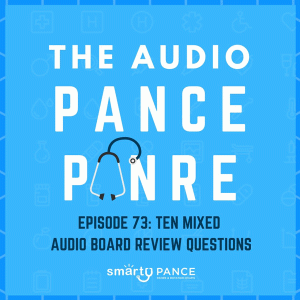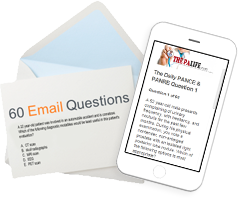Podcast: Play in new window | Download
Subscribe: Apple Podcasts | RSS
The Audio PANCE and PANRE Physician Assistant Board Review Podcast
Welcome to episode 73 of the Audio PANCE and PANRE PA Board Review Podcast.
Join me as I cover ten PANCE and PANRE Board review questions from the SMARTYPANCE course content following the NCCPA™ content blueprint (download the FREE cheat sheet).
This week we will be covering ten general board review questions based on the NCCPA PANCE and PANRE Content Blueprints.
Below you will find an interactive exam to complement the podcast.
I hope you enjoy this free audio component to the examination portion of this site. The full board review includes over 2,000 interactive board review questions and is available to all members of the PANCE and PANRE Academy and Smarty PANCE.
- You can download and listen to past FREE episodes here, on iTunes, on Google Play Music or Stitcher Radio.
- You can listen to the latest episode, take an interactive quiz and download your results below.
Listen Carefully Then Take The Practice Exam
If you can’t see the audio player click here to listen to the full episode.
Podcast Episode 73: Ten Question PANCE and PANRE Podcast Quiz
The following questions are linked to NCCPA Content Blueprint lessons from the Smarty PANCE and PANRE Board Review Website. If you are a member you will be able to log in and view this interactive video lesson.
1. A 45-year obese female (BMI=36.7 ) presents to your clinic with a random serum glucose level of 242. You diagnose the patient with type II diabetes and place her on metformin 500 mg twice daily and ask that she check her glucose first thing in the morning and again late at night. The patient states that her glucose first thing in the morning is 424 and by the evening it is 96. Which of the following tests would you like to order to confirm your diagnosis?
- ACTH level
- HgA1C
- 24 collection of VMA
- Dexamethasone suppression test
- Cortisol levels
2. A 49-year-old male is admitted to the hospital with a diagnosis of pneumonia. He has had a cough and fever up to 101.2 °F for five days. The patient states that his cough is productive and he is also complaining of sharp right-sided chest pain. On physical exam, you note diminished breath sounds on the right as well as dullness to percussion. The chest x-ray demonstrates a right lower lobe infiltrate. Which of the following bacteria would be the most likely cause of this patient’s pneumonia?
- Mycoplasma
- Pneumococcal
- H. Flu
- Legionnaires
- Chlamydia
3. A 21-year-old male is brought into the emergency room by his fraternity brothers. He appears confused and is agitated. He has a temperature of 100.5 F, horizontal nystagmus, muscular rigidity and at times becomes incredibly combative. His laboratory evaluation shows a CPK level of 8000 and his blood alcohol level is 0. Which of the following drugs most likely explains this patient’s symptoms?
- Methamphetamines
- LSD
- PCP
- Ecstasy
- Marijuana
4. A 51-year-old male presents to the ED complaining of substernal burning discomfort. He reports a history of mild hypertension and Raynaud’s phenomenon. On physical exam, you notice he has shortened fingers. When further questioned the patients states that he was once told that he may have a type of autoimmune disease but is unaware of the name. Which of the following medications would be most helpful for the patient’s chronic heartburn??
- Omeprazole
- Cimetidine
- Carafate
- Zofran
- Amlodipine
5. You are called to see a patient who is currently on multiple psychiatric medications including Lithium, Lorazepam, Abilify, Trazodone, and Sertraline. He also takes Lasix. He is in an assisted living facility and is brought to you by his care team for an acute psychotic episode. Which of the following medications is most likely responsible for the patient’s acute psychosis?
- Lorazepam
- Lasix
- Abilify
- Trazodone
- Sertraline
7. A 64-year-old male presents with a chief complaint of lower extremity pain while walking his dog every afternoon. What is the most important risk factor for developing peripheral vascular disease?
- Smoking
- Hypertension
- Elevated cholesterol
- Elevated triglycerides
- Diabetes
8. A 35-year-old male patient presents concerned about his cardiac risk factors. He has a low HDL level, hypertension, type II DM, and an elevated LDL and triglyceride levels. His brother had CAD at the age of 47. Which of the following risk factor has the highest value when determining this patients risk of developing CAD?
- Low HDL levels
- Hypertension
- Diabetes
- High cholesterol
- Family history
9. Which of the following is considered to be a 1st line medication used in endocarditis prophylaxis for high-risk patients undergoing invasive procedures such as an esophageal stricture dilation?
- Cipro
- Clindamycin
- Amoxicillin
- Clarithromycin
- Doxycycline
10. In a patient with a VSD murmur which of the following will be seen during the physical exam?
- Split S1
- Diastolic crescendo murmur
- Wide pulse pressures
- Holosystolic murmur
- Split S2
Looking for all the podcast episodes?
This FREE series is limited to every other episode, you can download and enjoy the complete audio series by joining The PANCE and PANRE Exam Academy + SMARTYPANCE
I will be releasing new episodes every few weeks. The Academy is discounted, so sign up now.
Resources and Links From The Show
- My list of recommended PANCE and PANRE review books
- Interactive PANCE and PANRE NCCPA Exam Content Blueprints
- Sign up for the FREE Daily PANCE and PANRE email series
- Join the Smarty PANCE NCCPA Content Blueprint Website + The PA Life Academy
- Get 20% of any Picmonic membership by using this link
- Use Code "PALIFE" and get 10% OFF THE RUTGERS PANCE AND PANRE REVIEW COURSE
This Podcast is also available on iTunes and Stitcher Radio for Android
- iTunes: The Audio PANCE AND PANRE Podcast iTunes
- Stitcher Radio: The Audio PANCE and PANRE Podcast Stitcher

Download The Content Blueprint Checklist
Follow this link to download your FREE copy of the Content Blueprint Checklist
Print it up and start crossing out the topics you understand, marking the ones you don't and making notes of key terms you should remember. The PDF version is interactive and linked directly to the individual lessons on SMARTY PANCE.
Download for PANCE Download for PANRE


